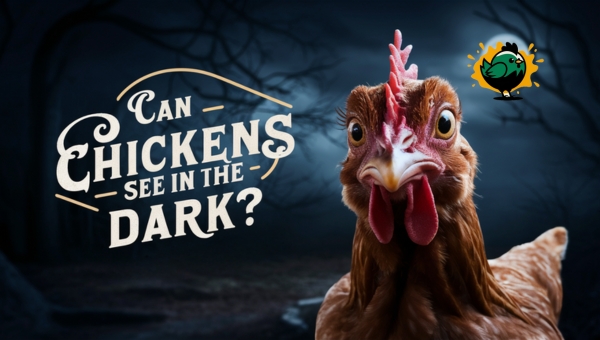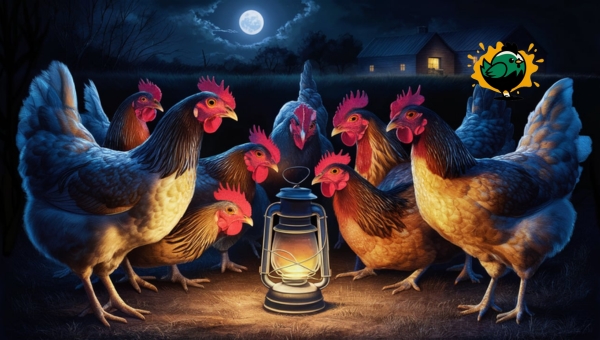Can Chickens See in the Dark? Find the Truth!

Imagine you’re in the countryside, the night is still, and the stars are twinkling. You hear faint clucking from the chicken coop. Have you ever wondered if, can chickens see in the dark? This question has puzzled many, especially those keen on understanding their feathery friends.
Chickens, with their early morning calls and daytime activities, seem to be creatures of the light. But what happens when the sun sets? In this article, we’ll explore the mysteries of chicken vision, debunk myths, and uncover how these birds navigate the shadows. Join us as we delve into the fascinating world of chickens’ eyesight.
Understanding Chicken Vision
Chickens have unique visual capabilities that allow them to see the world in a distinct way. Unlike humans, chickens possess a range of color perception that extends into the ultraviolet spectrum. This means they can detect colors that are invisible to the human eye.

Their eyes are positioned on the sides of their heads, providing a wide field of view. This helps them stay alert to potential predators. Although they cannot see in complete darkness, chickens can navigate in low-light conditions.
Their eyes contain more cones than rods, which is why their daytime vision is superior to their night vision. Chickens also rely on light cues for various behaviors, such as feeding and laying eggs.
Understanding these aspects of chicken vision is crucial for their care and management, ensuring their environment supports their natural visual needs.
Debunking Myths About Night Vision
When it comes to the vision of chickens, there’s a lot of speculation, especially regarding their capability to see in the dark.
This section aims to explore some common misconceptions and provide scientific evidence to clarify these beliefs. Let’s look into what people often get wrong about chickens’ night vision and what science has to say.
Common Misconceptions
Chickens are often misunderstood when it comes to their night vision. Here are some popular myths:
- Chickens can see perfectly in the dark: This myth suggests chickens have night vision akin to nocturnal animals.
- Chickens are completely blind at night: Contrary to this belief, chickens do have some level of vision in low-light conditions.
- Chickens are scared of the dark because they can’t see: This is not entirely true, as chickens have adapted ways to deal with darkness.
Scientific Evidence
Scientific studies shed light on chickens’ ability to see in the dark. Key evidence includes:
- Limited night vision capabilities: Research indicates that while chickens can’t see as well as nocturnal animals, they aren’t entirely blind in the dark.
- Eye structure: Studies show that chickens’ eyes have fewer rod cells compared to nocturnal birds, which affects their night vision.
- Adaptation mechanisms: Chickens rely on other senses and behaviors to navigate in low-light situations, supported by scientific observations.
How Chickens See In Low Light?
Chickens have a fascinating way of seeing in low-light conditions, which is quite different from humans or other animals. Understanding how they manage to navigate in dim light can be intriguing.

By exploring the unique structure of their eyes and the function of rods and cones, we can better appreciate their vision abilities.
Structure Of Chicken Eyes
The structure of chicken eyes plays a significant role in their ability to see in low-light environments.
Here are some key points about their eye structure:
- Large Eye Size: Chickens have relatively large eyes compared to their head size, allowing more light to enter, which is crucial for seeing in dim conditions.
- Wide Field of View: Their eyes are positioned on the sides of their head, providing a broad field of view that aids in detecting movement and changes in light.
- Pecten Oculi: This is a unique structure in chicken eyes that helps supply nutrients and oxygen, enhancing their overall vision capabilities.
Role Of Rods And Cones
Rods and cones in the eyes are essential for vision, and in chickens, they perform specific roles under low light:
- Rods: These cells are more sensitive to light and are responsible for vision in dim lighting. Chickens have a higher number of rods, enabling them to see better in low-light situations.
- Cones: Although cones are less effective in low light, they are vital for color vision during daylight. Chickens have a variety of cones, which help them perceive colors when enough light is present.
These features combined allow chickens to adapt to varying light conditions efficiently.
Also Read: Can Chickens Fly? Exploring Their Flight Capabilities
Comparing Chicken Vision To Other Animals
Understanding how chicken vision stacks up against other animals can offer some fascinating insights. Chickens have unique visual capabilities, but how do they compare to creatures adapted for nighttime activities or to mammals with different visual needs?
Chickens Vs. Nocturnal Birds
When comparing chickens to nocturnal birds, the differences in vision become clear. Nocturnal birds are equipped with special adaptations that allow them to thrive at night:
- Large Eyes: Nocturnal birds have larger eyes compared to their body size, enabling them to capture more light.
- High Rod Density: Their retinas are packed with rods, which are essential for seeing in low-light conditions.
- Reflective Layer: They often possess a reflective layer behind the retina, enhancing their ability to see in the dark.
In contrast, chickens lack these adaptations, making them less suited for darkness.
Chickens Vs. Mammals
Contrasting chicken vision with that of mammals highlights some intriguing differences. Mammals, like humans, have evolved to meet various environmental demands:
- Color Vision: Many mammals possess color vision, though not as vibrant as chickens, who have more types of cones.
- Night Vision: Some mammals have a higher proportion of rods, aiding their night vision, unlike chickens.
- Field of View: Mammals often have a wider field of view, adapted to detect movement.
Chickens, while having superior color vision during the day, do not share the same nocturnal capabilities or field adaptations.
Practical Implications For Chicken Farmers
When it comes to managing chickens, understanding their vision is essential. Farmers must consider how chickens interact with their environment, especially concerning light.
Proper lighting can significantly impact their well-being and productivity. Let’s explore how lighting conditions can be optimized to suit their visual requirements and examine the effects of lighting on their behavior.
Lighting In Chicken Coops
Lighting plays a crucial role in the daily life of chickens. Given their unique vision, it’s important to ensure that chicken coops have the right amount of light.
- Natural Light: Whenever possible, use natural light to maintain a natural day-night cycle. This helps chickens stay in tune with their natural rhythms.
- Artificial Light: When natural light isn’t enough, supplement it with artificial lighting. The lights should be evenly distributed to avoid shadows, which can make chickens uneasy.
- Light Duration: Aim for about 14-16 hours of light per day. This duration supports egg production and keeps the chickens active.
Impact On Chicken Behavior
Lighting doesn’t just affect chickens physically; it also influences their behavior and overall well-being. The amount and quality of light in their environment can lead to various outcomes.
- Activity Levels: Adequate lighting encourages chickens to be more active during the day, promoting better health and growth.
- Stress Reduction: Consistent lighting reduces stress levels, as sudden changes in light can be unsettling for chickens.
- Social Interaction: Proper lighting fosters social behavior, as chickens can see each other clearly and interact more naturally.
By paying attention to lighting, farmers can create an environment that supports the health and productivity of their chickens.
Conclusion
Chickens have a limited ability to see in the dark compared to nocturnal creatures. Their vision is more suited for daylight activities, with low-light adaptability being only moderate. Understanding how chickens perceive their environment helps in providing optimal care, especially concerning lighting conditions in coops.
By ensuring proper lighting, chicken farmers can positively influence the behavior and well-being of their flocks. Through exploring chicken vision, we gain insights into enhancing their living conditions, leading to better productivity and health.
If you found this article informative, explore more on our site for additional insights into chicken care and farming practices.
